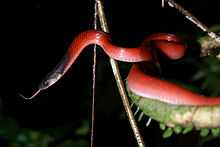Oxyrhopus melanogenys
| Oxyrhopus melanogenys | |
|---|---|
 | |
| Conservation status | |
| Scientific classification | |
| Kingdom: | Animalia |
| Phylum: | Chordata |
| Subphylum: | Vertebrata |
| Class: | Reptilia |
| Order: | Squamata |
| Suborder: | Serpentes |
| Family: | Colubridae |
| Subfamily: | Xenodontinae |
| Genus: | Oxyrhopus |
| Species: | O. melanogenys |
| Binomial name | |
| Oxyrhopus melanogenys (Tschudi, 1845) | |
| Synonyms | |
Oxyrhopus melanogenys, commonly known as Tschudi's false coral snake, is a colubrid snake species found in the northern part of South America.
Description
Adults may attain a total length of 68 cm (27 in), which includes a tail 17 cm (6.7 in) long.[3]
Dorsally, it is red or reddish brown, with the dorsal scales black-edged or black-tipped. There may be a few black crossbands in groups of three (triads) on the anterior portion of the body. The top of the head and the nape of the neck are black. Ventrally, it is yellowish.[3] It is often confused with Oxyrhopus trigeminus.
The dorsal scales are smooth, with apical pits, and are arranged in 19 rows at midbody.[3]
Subspecies
There are two subspecies, including the nominate subspecies:[4][5]
- Oxyrhopus melanogenys melanogenys (Tschudi, 1845)
- Oxyrhopus melanogenys orientalis Cunha & Nascimento, 1983
Geographic range
O. m. melanogenys is native to Bolivia, Peru, Brazil (Rondônia, Amazonas, Pará), Ecuador, Colombia, Guyana,[6][7] Venezuela (Amazonas, Bolívar).[8]
O. m. orientalis is found in Peru and Brazil (Pará).[4]
References
- ↑ Doan, T.M., Lundberg, M. & Lamar, W.W. (2010). "Oxyrhopus melanogenys". IUCN Red List of Threatened Species. Version 2014.2. International Union for Conservation of Nature. Retrieved 24 October 2014.
- ↑ The Reptile Database. www.reptile-database.org.
- ↑ 3.0 3.1 3.2 Boulenger, G.A. 1896. Catalogue of the Snakes in the British Museum (Natural History). Volume III., Containing the Colubridæ (Opisthoglyphæ and Proteroglyphæ),... Trustees of the British Museum (Natural History). (Taylor and Francis, Printers.) London. xiv + 727 pp. + Plates I.- XXV. (Oxyrhopus melanogenys, p. 105.)
- ↑ 4.0 4.1 Oxyrhopus melanogenys. Catalogue of Life: 2010 Annual Checklist
- ↑ No subspecies are currently recognized by ITIS. See: "Oxyrhopus melanogenys". Integrated Taxonomic Information System. Retrieved 2011-03-23.
- ↑ Cole, C.J., C.R. Townsend, R.P. Reynolds, R.D. MacCulloch and A. Lathrop (2013). "Amphibians and reptiles of Guyana, South America: Illustrated keys, annotated species accounts, and a biogeographic synopsis". Proceedings of the Biological Society of Washington 125: 317–620. doi:10.2988/0006-324x-125.4.317.
- ↑ MacCulloch, R.D., A. Lathrop, P.J.R. Kok, R. Ernst and M. Kalamandeen (2009). "The genus Oxyrhopus (Serpentes: Dipsadidae: Xenodontinae) in Guyana: morphology, distributions and comments on taxonomy". Papeis Avulsos de Zoologia 49: 487–495.
- ↑ Zaher, H. & U. Caramaschi (1992). "Sur le statut taxinomique d'Oxyrhopus trigeminus et O. guibei (Serpentes, Xenodontinae)". Bulletin du Museum national d'Histoire naturelle. (4)14a(3-4): 805–827.
Further reading
- Cunha, O.R. da, and F.P. do Nascimento. 1983. Os Ofidios da Amazônia. XIX. As espécies de Oxyrhopus Wagler, com uma subespécie nova, e Pseudoboa Schneider, na Amazônia orientale e Maranhão (Ophidia: Colubridae). Boletim do Museu Paraense Emílio Goeldi, Nova Série, Zoologia (112): 1-42. (Oxyrhopus melanogenys orientalis)
- Tschudi, J.J. 1845. Reptilium conspectus quae in Republica Peruana reperiuntur et pleraque observata vel collecta sunt in itinere. Archiv für Naturgeshichte 11 (1): 150-170. (Sphenocephalus melanogenys, p. 163.)
| ||||||
